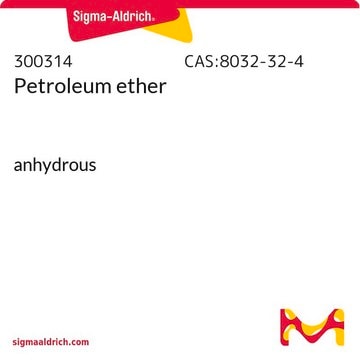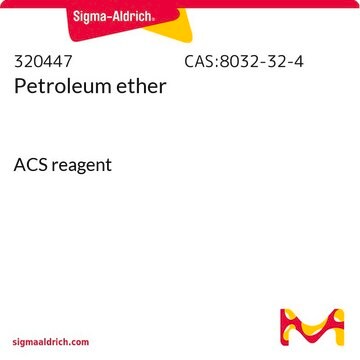673838
Petroleum ether
ACS reagent
About This Item
Produits recommandés
Qualité
ACS reagent
Densité de vapeur
2.5 (vs air)
Pression de vapeur
25.8 psi ( 55 °C)
7.99 psi ( 20 °C)
Forme
liquid
Température d'inflammation spontanée
475 °F
Limite d'explosivité
8 %
Impuretés
acidity, passes test
Résidus d'évap.
≤0.001%
Couleur
APHA: ≤10
Indice de réfraction
n20/D 1.363 (lit.)
Point d'ébullition
30-60 °C (lit.)
35-60 °C
Densité
0.64 g/mL at 25 °C (lit.)
InChI
1S/C7H7.BrH.Mg/c1-7-5-3-2-4-6-7;;/h3-6H,1H3;1H;/q;;+1/p-1
Clé InChI
ZRJNGFJIBZKXTP-UHFFFAOYSA-M
Vous recherchez des produits similaires ? Visite Guide de comparaison des produits
Description générale
Application
- Soluble compounds from the mushroom samples.
- Carotenoids from the marine Thraustochytrium sp.ONC-T18.
Mention d'avertissement
Danger
Mentions de danger
Conseils de prudence
Classification des risques
Aquatic Chronic 2 - Asp. Tox. 1 - Flam. Liq. 1 - Skin Irrit. 2 - STOT SE 3
Organes cibles
Central nervous system
Code de la classe de stockage
3 - Flammable liquids
Classe de danger pour l'eau (WGK)
WGK 2
Point d'éclair (°F)
-56.2 °F
Point d'éclair (°C)
-49 °C
Certificats d'analyse (COA)
Recherchez un Certificats d'analyse (COA) en saisissant le numéro de lot du produit. Les numéros de lot figurent sur l'étiquette du produit après les mots "Lot" ou "Batch".
Déjà en possession de ce produit ?
Retrouvez la documentation relative aux produits que vous avez récemment achetés dans la Bibliothèque de documents.
Les clients ont également consulté
Notre équipe de scientifiques dispose d'une expérience dans tous les secteurs de la recherche, notamment en sciences de la vie, science des matériaux, synthèse chimique, chromatographie, analyse et dans de nombreux autres domaines..
Contacter notre Service technique













